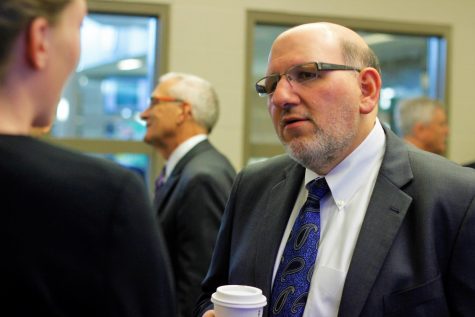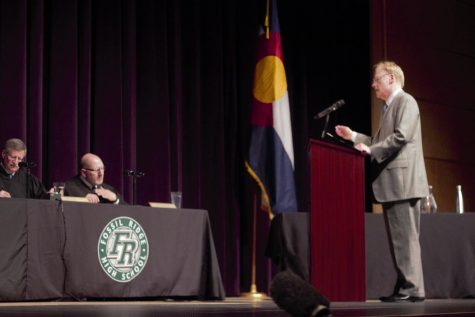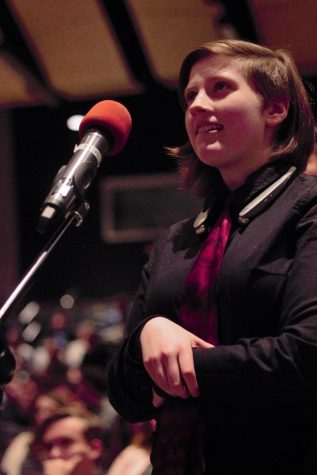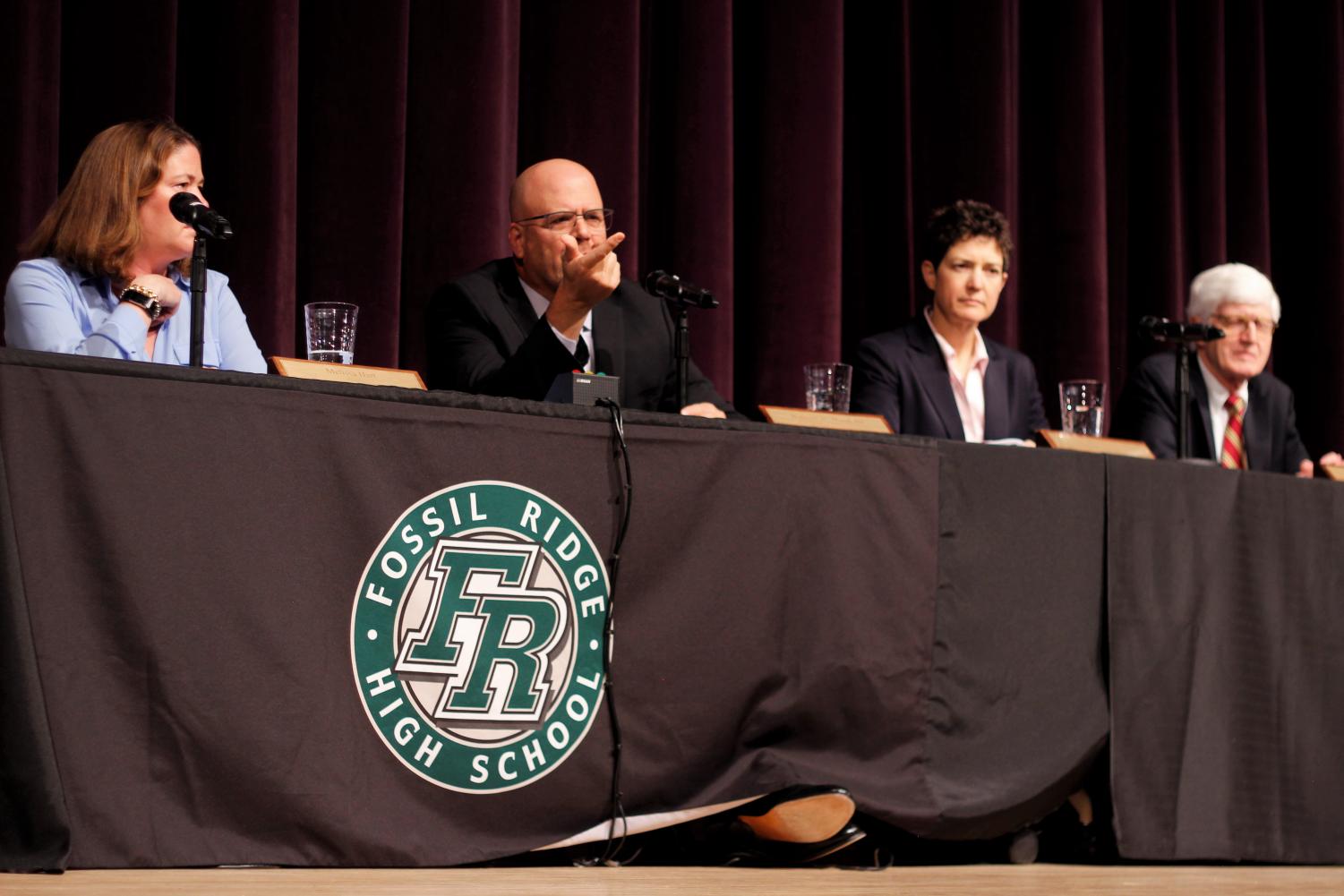Your donation will support the student journalists of Fossil Ridge High School. Your contribution will allow us to purchase equipment and cover our annual website hosting costs.
Opinion: What we learned from Courts in the Community
October 20, 2018
On Thursday, October 18, Fossil Ridge High School was given the opportunity to host Courts in the Community, a Colorado program that aims to give high school students a better understanding of the judicial process in the United States. Through the program, the Colorado Supreme Court heard arguments for two cases in Fossil’s Performing Arts Center.
The program began in 1986, and the court continues to travel to two high schools each year today. According to the Colorado Judicial Branch’s website, “[The program] gives high school students hands-on experience in how the Colorado judicial system operates and illustrates how disputes are resolved in a democratic society.” Fossil was nominated for Courts in the Community several years ago, and was picked this year.
Every senior at Fossil is required to take a government class, and each student currently in one was invited to watch the cases. In addition, several U.S. History classes, Debate classes, and members of clubs like Model United Nations were invited to attend. Each teacher was also allotted several spots at a luncheon subsequent to the arguments, and they picked a handful of their students based on interest in the judicial process. At the luncheon, five or six students and a teacher sat at a table with a justice to ask questions.

Justice Carlos A. Samour, Jr., the most junior justice on the bench, attended the opening breakfast among fellow justices, major political figures in Colorado, Poudre School District board members, and Fossil Ridge Staff.
The arguments heard by the Colorado Supreme Court happened exactly as they would’ve in the courthouse, but the day began with remarks by principal Julie Chaplain and Chief Justice Nathan B. Coats, among others. Students learned about the difference between a jury trial, which intend to determine whether criminal charges are due, and an appellate court, in which the issue in question is about constitutionality of court proceedings. In an appellate court, no new information can be provided – lawyers simply make an argument based on the proceedings of the previous trials and the known information, and the justices can ask questions based on what they hear.
The court then heard People of the State of Colorado v. Mikel Morehead and People of the State of Colorado v. Simon Kubuugu. Previously to the event, students were given packets prepared by the lawyers and court staff which explained the cases without excessive legal jargon. Each lawyer was given half an hour to make their argument to the court, and once that was done, the justices took recess.
As Justice Richard L. Gabriel explained at the luncheon, the justices take an initial vote on the case when they take recess. They discuss their thoughts, and then the Chief Justice picks one member of the majority to write the majority opinion. However, the justices can change their minds until the opinion is published, which usually takes several weeks or months.
When the justices returned from initial deliberations, students could ask them questions as well. Justice Melissa Hart explained that she loves holding court in high schools because, “you guys are so excited about the law, and not jaded yet.” Several justices agreed with Hart, finding that Courts in the Community gives everyone involved a chance to learn something. The justices also specifically thanked the sound crew, which consisted of Fossil TV students, for the clearest sound they have ever had at a high school. The TV program also created the official record of the proceedings.
“All Rise”
As a four-year Journalism student, I’ve been learning how to ask the difficult questions for a long time. I’ve been to workshops, conferences from Colorado State University to San Francisco, and practiced over and over again. I’m still, however, not the type to rock the boat while looking straight into someone’s eyes.
When Fossil Ridge High School was picked to host Courts in the Community, I was thrilled. I’m considerably more politically active than your average high school student – one look at the number of articles in our opinion section with my name on them demonstrates it. I pride myself on always knowing what is going on in our world, and, perhaps as an idealistic seventeen-year-old, the democratic process gives me chills.
In addition, the Supreme Court is a critical entity. Their decisions set precedent that all lower courts must follow, and that fact wasn’t lost on me even as each senior in a government class muddled through packets that laid out the two cases that would be heard. It was fascinating to hear my peers comes to piecewise realizations – first, that any Supreme Court is an appellate court, rather than a trial one. Initially, the average one among us was almost certainly picturing a jury, a single judge with a podium and a gavel, and witnesses on the stand.
Second was the realization that the court would not be handing down a sentence, but ruling instead on the constitutionality of a process. Again, as teenagers with access to nearly every TV show imaginable, we pictured the defendant being hauled away in handcuffs before our eyes. The reality was, by some standards, far less exciting. Lawyers for each party explained their arguments to the court, who responded with questions that attempted to understand or prod.
Students filed into the Performing Arts Center the morning of October 18 with their friends, excited for a break in the everyday pattern of Thursday classes. The event could have been any other in a high school, with some people there because they had to be, some who were vaguely listening, and some who were legitimately curious about what they were about to learn.
When the bailiff said, “All rise”, though, everything shifted. Every high schooler in the room jumped to their feet with the quickness of a military cadet, not just to fit in but because power settled heavy in the PAC as the justices entered. There was complete and utter silence for those few moments, in which one could actually hear each young mind clicking with, “this is how history happens.” I was enraptured by the scene in front of me along with hundreds of my fellow Sabercats.

After each case, students were given the opportunity to ask questions of the attorneys. Pictured here, senior Jackson Holland asks a question after the Morehead hearing.
As the first argument began, though, I was honestly disappointed. The lawyers and justices conversed in language so thoroughly woven with legal jargon that it was unintelligible to most students. For the first five minutes, we gazed, wide-eyed, around at one another, trying to force our minds to comprehend what we were hearing and generally failing. Without turning my head, I could see three kids who were completely asleep – and I was sitting in the second row. The attitude in the room was not one of boredom but one of disappointment, because us students had truly been excited to be a part of this day.
However, the attitude shifted again when the arguments ended and students were allowed to come to the microphone and ask questions of the lawyers and of the justices themselves. I watched as my peers’ eyes became alight with excitement and inquisitiveness. They asked about the facts of the cases, how the court makes decisions, and why the lawyers said what they did.
My peers were daring, asking questions that directly poked holes in the lawyers’ arguments. There was a bit of mischief and a whole lot more curiosity in the way they approached the microphone, some confidently and others quietly, to find out how the justices and the lawyers got to where they are today and what steps we should take now to set ourselves up for the future.
My fellow students showed not only interest but awe. They were polite and respectful, all while asking questions I still would not think to today. They recognized Courts in the Community for what it was – not just a chance to miss class, but one to be a part of something much bigger. Not just to sit in Government and talk about the judicial process, but actually witness its effects.
My peers demonstrated that, for the reputation that teenagers are handed of being selfish and uninformed, they deeply care about democracy in our country. They questioned it, pondered it, participated in it. And they made me unimaginably proud.
Engaged students, engaged citizens
I learned many things at the Supreme Court hearing held at Fossil Ridge High School, among them that the justices are not nearly as intimidating as they are perceived. While at the breakfast preceding the hearing, I heard many conversations that were nothing like what I had expected. In a room full of incredibly important people, including justices, government officials, and school board members, I heard reunions between friends and colleagues, discussions of kids and families, and plans for the weekend. I had never considered that the justices would be so “normal”. Being members of the highest court in Colorado they are held in high regard, and I was surprised to have so much in common with them.

Following the hearing, selcet students were chosen for a luncheon with the justices. Here, Olivia Doro talks to Justice Melissa Hart over sandwiches and chips.
My experience at the supreme court hearing was distinctly different from that of the majority of my peers in that I was able to eat lunch with Justice William W. Hood III. We discussed his background and the inner workings of the judicial branch of the United States. He was also incredibly passionate about the Courts in the Community initiative in Colorado, explaining, “I think it’s important that people get a real sense of how the decisions are made and it provides a transparency that is healthy in society. It also acts as a catalyst for kids thinking about law.”
Additionally, Justice Hood stressed the importance of political involvement in young people, saying, “It encourages students to think about larger issues and become engaged citizens, which is important because it’s far too easy to not worry.”
In my years of high school, I have helped organize a walk-out, been a founding member of Larimer Young Democrats, and formed a branch of #NeverAgain in Northern Colorado. Though I can’t vote in the midterms, I have looked over the ballot and familiarized myself it. I consider myself a fairly informed person, whether that be due to journalism or otherwise. However, I know the majority of my generation is not like that, as we have the lowest voter turnout of any demographic. Programs like Courts in the Community can change that.
For every student I saw sleeping through the hearing, I saw ten taking notes, listening intently, or asking questions. Opportunities such as this do not come up often for high schoolers, and to see my peers learning in a completely new way was empowering. There is only so much someone can learn in a classroom, and Courts in the Community poses a completely new idea of how an education can look.
The purpose of an education is to teach young people about the world and real world experiences, such as attending a Supreme Court hearing are critical in schooling. As we go forth into the adult world, we have an obligation to be engaged citizens in order to initiate change. In the words of Justice Hood, “We should be worried about the future and doing everything we can to make the world a better place.”
The impact of Courts in the Community
Hundreds of students shuffled into the PAC with eager eyes and ears – not only to hear, but to be inspired by what they were about to witness. Seven Supreme Court justices from the state of Colorado came to our school on Thursday, October 18. Once the gavel struck the wood, every student in the PAC was hushed as they stood for the justices. It was a rare opportunity that students may never encounter again. Attorneys from both sides of a case argued on our stage to show the judges what they were made of, and to show the students what really happens in court. Fossil Ridge High School has been aiming to do this for years, and with the help of Dr. Chaplain and Assistant Principal Mark Barry, it was possible.

Per regulation, each side was given 30 minutes to present their case to the Supreme Court. This is a time for the justices to ask clarifying questions and dig deeper in the argument.
I joined the mob of high schoolers today with my Argumentation and Debate class. Thanks to my teacher, I know the details and intricacies of these cases like the back of my hand. I was expecting a basic review with a couple of fancy interjections of legal jargon. But, as the lights slightly dimmed and the justices filed in, I could tell, and all the students around me could too, this was going to be special. The attorneys started with a bang, a timer counting them down from thirty minutes while justices asked questions for every issue that crossed their mind. After both sides argued, there was a chance for rebuttal. Finally, the microphone turned to the crowd. We were able to ask the attorneys about their experience, duties, and life before studying the law. When else can one do this? Students were able to approach the microphone freely and have a connection with the attorneys, a once-in-a-lifetime opportunity. Once both cases argued and presented their evidence, students were permitted to ask the justices questions. The students asked questions that I wish I had thought of, but I was amazed at the answer to. One student approached the microphone and asked why these people chose to impact our state on the highest level. Justice Monica M. Márquez stated, “I didn’t imagine being here…over time I just realized that I had a tremendous love [of law]”.
Why does this matter? Not only did this experience teach me about the courtroom experience, but it proved to me that those with differing opinions can still be civil, and that our legal system is less flawed than I once thought. Most importantly, the legal system cares about the community and students, and that the students care in return. The attorneys eloquently answered questions on the fly, as high school students strive to do. One attorney even stated that she was involved in the debate team in high school. They may have separate opinions, but they are fighting for justice and equality together. In the midst of recent Supreme Court Justice dilemmas, it is so important for high school students to remember that our legal system is affected by your voice, and that your view matters. With classes like AP U.S. History and clubs like Speech and Debate, your voice will be developed and heard. This experience opened my eyes and showed me how involved our community and students really are in the legal system. Students at Fossil Ridge High School are devoted and determined; this experience just showed us how to use those traits to shape our world.
Atticus Finch and Expert Testimony: Why we need Courts in the Community
We’ve all learned about the branches of government from a young age, about the nuances of the legislative, executive, and judicial branches. However, in a suburban environment and lacking the power to vote, this all, at a certain point, becomes an abstraction. What exactly does it all mean?
Perhaps when you think of court, you recall watching Atticus, in all his monochrome glory, argue racial justice on film in your English class. Perhaps you remember Billy Flynn, presenting homicide cases in musical form in Chicago. Heck, maybe you even hold Judge Judy as your exemplifying example of the American justice system.
But what is court really like? As adolescents and as minors, most of us have (fortunately) never experienced it firsthand.

Students were given the opportunity to understand how the judicial branch worked and came away knowing more than they did before.
The first and foremost thing to be noted about the Colorado Supreme Court’s visit to Fossil Ridge High School was the formality. No cellphones, questions about particular things at particular times, all the formalities of the national anthem when the justices enter and exit, and ambiguous legality of photography. The court proceeding was not a casual event, nor was it something to trifled with.
The other most distinguishing element of the experience was it’s particular dryness. While attorneys for the People of Colorado and for Mikel Morehead and Simon Kubuugu went back and forth with the justices on the technicalities of how evidence was obtained and used, they brought up and argued with legal terms and past cases with no relevance or meaning to the audience. They continually returned to and picked apart ethics and minor details from every angle, analyzing every aspect of the case.
As vital to our society as it is, Supreme Court cases were not made to be a spectator sport.
All too often, the workings of our government fail to truly be understood by American citizens. Democracy and justice become distant concepts, seen on television and left to be handled by others. Courts in the Community alleviates this; students and members of the community witness governmental proceedings up close and personal. Fossil students left school on Thursday, October 18 knowing how justice works at the highest level of our state (or at least understanding it a bit better.) This process affects our day-to-day lives, whether or not we realize it; it’s to our benefit to see it happen at least once.
Courts in the Community took place over three class periods. I missed review for a French test, a few worksheets in U.S. History, and work time for the unending projects of Journalism. However, the experience was, perhaps, a once in a lifetime opportunity, and I instead had the chance to actively observe deliberations that will set precedent for other cases for decades. In three class periods, I learned more about the justice system from sitting in the second row of the auditorium than I’ll learn from any class textbook.
This, my friends, is democracy: it’s here, and it’s now.

